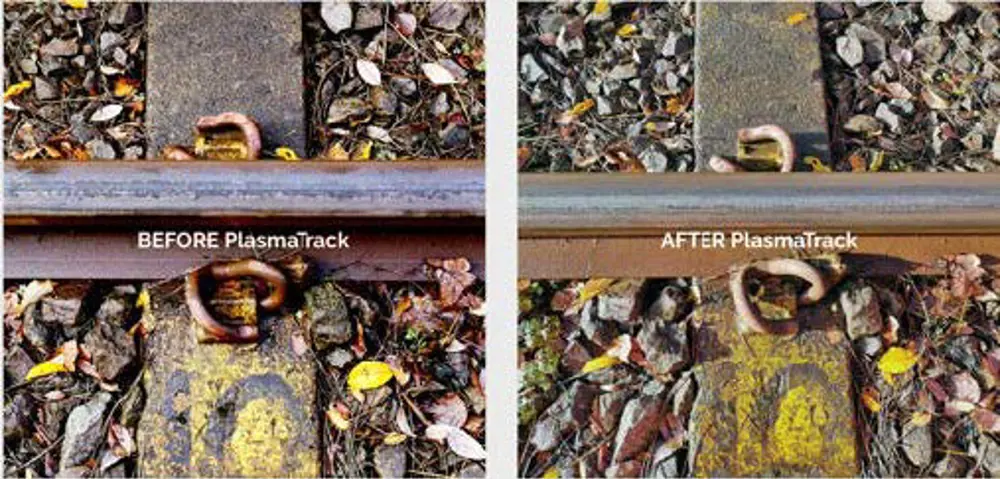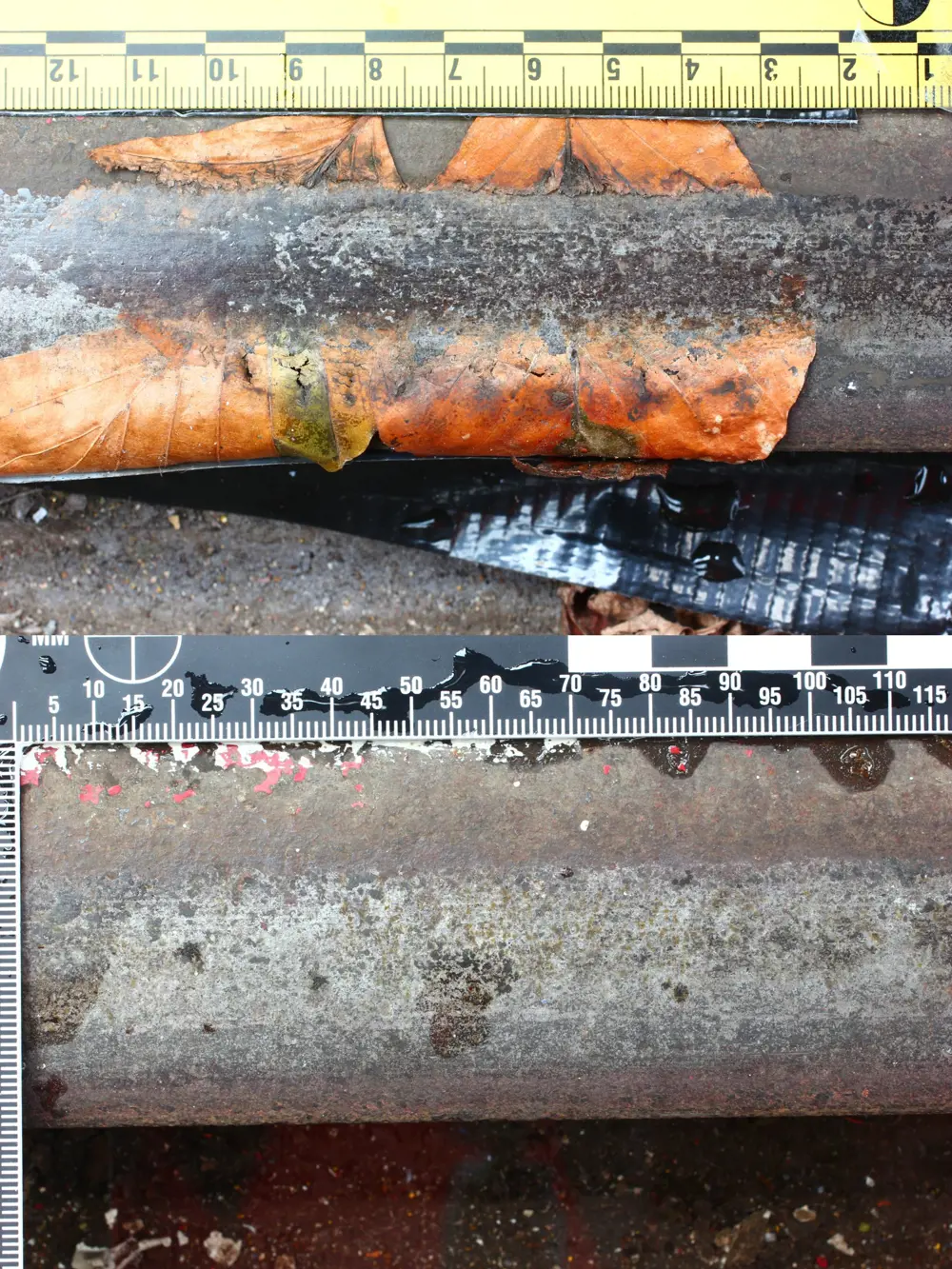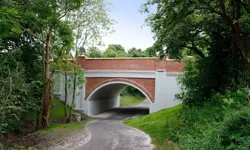
Leaves on the line
Did you know?
🍂 Fallen leaves on railway lines
- Fallen leaves on railway lines cause trains to slip and cause delays
- Leaves and other debris are currently cleaned by high-pressure water jets
- Engineers have developed technologies using plasma, ultrasound, laser, and dry ice to clean rails
Of the reasons put forward to account for the ‘operational difficulties’ that can disrupt railway timetables, few earn more scorn, derision or even downright disbelief than that of delays caused by ‘leaves on the line’. Even the most well-informed passengers may find this explanation – a loss of adhesion between train and track – rather hard to swallow. The scepticism is understandable; when steel wheels press with a force of 30 tonnes/square inch on to small areas of unyielding steel rail, the suggestion that traction between the two can be thwarted by something as fragile and insubstantial as a few leaves is certainly counterintuitive.
The hard, black, thin, slippery layer that forms on the surface of leaf-covered rails subjected to the pressure exerted by a train’s wheels is not completely understood. The physics and chemistry of these leaf deposits is still debated, but they comprise a mixture that includes cellulose, cellulose acetate and the amino acid tyrosine. How this bonds so firmly to the metal surface is uncertain, and many questions remain.
The extent to which leaves undermine adhesion has varied over time. The disappearance of steam locomotives in the 1960s eliminated the risk of trackside fires, and vegetation that had that had hitherto been cut back was left to flourish. Leaves then became an increasing problem. More recent troubles with adhesion reflects the lighter weight of modern trains.
The Rail Safety and Standards Board (RSSB), the body charged with delivering a better UK railway system, is looking for an alternative to the current method of tackling the leaf problem, with Network Rail or relevant train operators making a final decision.
The problem with leaves and slippery rails
Although by far the most troublesome, leaves are not the only cause of slippery rails. Lubricants dripping from rolling stock, for example, can play a part. Nor is the concern with adhesion a recent phenomenon, says Professor Simon Iwnicki FREng, Director of the Institute of Railway Research at the University of Huddersfield. An interest in the topic goes back to the earliest days of the railway, when some engineers were initially sceptical that steel-on-steel adhesion could generate the traction required to pull any but the lightest loads.
The logistics of real-world testing of railway innovations are unavoidably burdensome and costly, but preliminary studies can be laboratory-based. The University of Huddersfield’s rolling contact, adhesion and braking test rig incorporates rails wrapped around a two-metre diameter rotating drum that can handle 10-tonne full-scale wheel frameworks at speeds of up to 125 mph. There are also now several computer models of adhesion that, besides their role in studying adhesion itself, can be used for tasks such as optimising driving performance in low adhesion conditions and evaluating proposed changes to brake systems.

PlasmaTrack’s system can be mounted onto passenger trains and can clean the entire network
The extent to which leaf deposits reduce adhesion is clear from measurements of the relevant coefficients of friction. The adhesion of a train on dry rails is roughly 0.25. If the rails are wet the figure might fall to 0.15. If the rails are covered in damp leaf deposits it could be no more than 0.015.
Jokes about leaves on the line divert attention from the real cost of leaf-induced delays. The density of traffic on the UK’s railway system has roughly doubled in the past 20 years. If the risk of slippage during braking could be eliminated, the gap between successive trains could be reduced, increasing the capacity of the network.
The annual cost of delays caused by leaf slip, and of the actions taken by Network Rail to clean the rails, adds up to £350 million. More rarely, but also more dangerously, a loss of adhesion can lead to platform overruns and the greatest of all railway nightmares, the SPAD (or signal passed at danger).
The annual cost of delays caused by leaf slip, and of the actions taken by Network Rail to clean the rails, adds up to £350 million
When developing any novel leaf removal system, the initial phases are conducted in the laboratory using short lengths of rail on which leaves have been crushed under high pressure. To carry out systematic tests using real trains running on real rails, testers manually cover as long a length of track as is needed with moist leaves, and then slowly run trains over them as many times as it takes to generate the required deposit. They then drive the train over the leaf-covered section at a set speed and measure the stopping distance with the brakes full on.
The current technology for removing leaf deposits relies on a fleet of trains comprising several wagons that carry large tanks of water and high-pressure spraying equipment. Nozzles spray the water on to the rails at the rate of some 1,000 litres/minute at a pressure of 1,500 bar: sufficient to damage the rail if directed continuously at any one point. The cleaned surface may also be treated with a sand-containing gel that dries as a traction-boosting deposit on the railhead. Every autumn these trains trundle round the network doing the job they’ve been doing for several decades. But Network Rail would like a more efficient cleaning technology, performed by trains travelling at speeds of perhaps 60 mph.

PlasmaTrack’s technology removes the leaf layer (left) and creates a clean surface (right)
Plasma as an alternative leaf-cleaning method
One of the alternatives to current leaf-cleaning methods is plasma. Often described as the fourth state of matter, a plasma forms in a gas subjected to a high voltage, which causes electrons to be ripped away from their atoms to form a superheated soup of positively and negatively charged particles: ions and electrons respectively. The practical applications of plasmas range from fluorescent lighting to welding and, significantly, surface cleaning. PlasmaTrack, the company responsible for exploring this approach to the leaf problem, discovered in archives dating from the late 1960s that researchers working for the former British Rail had already investigated the use of plasmas. Although the technology got as far initial trials it was abandoned, and then forgotten.
PlasmaTrack uses the most readily available gas: nitrogen. It is piped, at pressure, to a delivery system where it is subjected to a high voltage, which produces plasma that then emerges as a jet from a nozzle set a few centimetres above the rail head. The temperature at the plasma’s core is around 10,000oC. The rail surface that receives the plasma jet reaches a peak of 700oC – enough to vaporise any leaf material. Because the heating is transient and superficial, the rail itself is left undamaged. Proof of concept laboratory studies using pieces of rail contaminated with leaf deposits demonstrated that the technique is effective.
In the future, says Julian Swan, CEO of PlasmaTrack, miniaturisation might allow the equipment to be incorporated into service trains, possibly fitted with several nozzles operating at lower power.
The nitrogen that the PlasmaTrack system relies on is extracted from air that has been compressed and then scrubbed of its oxygen by travelling through a standard nitrogen generator. Although this adds to the bulk of the equipment, using a generator avoids the need to handle and replace heavy and cumbersome bottles of the gas. Besides tanks to store the compressed air and nitrogen, other necessary equipment includes a power generator, an inverter, the ignition box for triggering the plasma, and a chilling system for cooling the plasma head.
Having shown that a 5 kW plasma jet would achieve the required cleaning, the company’s next step was to transfer the system to a vehicle moving on real rails at a test track. The equipment was loaded into a six-metre container mounted on a wagon fitted with the plasma delivery head. This demonstrated that a 15 kW plasma jet was effective in cleaning at speeds of up to 15 mph.
Having completed an 18-month period of feasibility testing, PlasmaTrack set about miniaturising the equipment and fitting it to a prototype road-to-rail vehicle that might be suitable for low-speed leaf cleaning on rural lines. Using a road-to-rail vehicle on a working stretch of track in Wales, it began real-world testing with a 100 kW system moving at speeds of up to 20 mph. The aim now is to treble that.
Further reductions in equipment volume should be possible by, for example, replacing the system’s own generator with a power feed from the locomotive pulling the wagon. In the future, says Julian Swan, CEO of PlasmaTrack, miniaturisation might allow the equipment to be incorporated into service trains, possibly fitted with several nozzles operating at lower power.
Network Rail has selected PlasmaTrack to demonstrate its high-speed system on live network at 60 mph in autumn 2021 and Network Rail Wales will be using its low-speed road-to-rail system for 10 weeks at the same time.
When it comes to cost comparisons with the existing water jet system, Swan believes that the plasma system will prove “comparable if not better”. But he also argues that even if the fuel bills were similar, the plasma system will score higher on speed and effectiveness.
A different way of using water in rail cleaning
Although train operators looking to replace high-pressure water jets in rail cleaning, a different way of using water is not ruled out. John Cooke and Simon Barnard of Water-Trak based their technology on a fundamental observation: while leaf residues on a rail cause problems when moist, the loss of traction largely disappears when the surface is either completely dry or thoroughly wet. This led them to wonder if the remedy might be found not in blasting residues off with high-pressure water, but simply ensuring that the rail surface was completely wet. They tested the possibility in a laboratory and showed that this was so.
To test the system on a real train running on real rails the company, like others, first had to create a realistic leaf coating on an appropriate length of railway track. It manually covered rails with moist leaves and ran a train over them half a dozen times to ensure the leaves were firmly crushed on to the rails. To test the effect of the leaves on braking, the train driver applied the brakes in a leaf-covered section of track. The braking distance at the chosen speed of 18 mph averaged out at 97 metres. The test was then repeated with the water system turned on and the braking distance averaged 76 metres. Last October the system was also tested on a service train, racking up some 120 miles.

The Water-Trak set up comprises a storage tank and a control system to activate and regulate the flow of water, which is delivered by pipe to a point on the rail just ahead of the train’s front wheel. It uses water at a pressure of 7 bar and a flow rate through the nozzle and on to the rail of around 3 litres/minute. The aim is to deposit 1 ml to 4 ml of water on each metre of track.
One criticism might be that while the Water-Trak system restores traction, it doesn’t remove the leaf deposits responsible for the problem. According to John Cooke this is not quite the case. Although the passage of wheels over leaves certainly creates the problem, that same passage gradually erodes the residue: a process that is aided by wetting the rail. So, in solving the immediate problem of slippage, it also creates conditions in which normal operation deals with the underlying problem.

The bubbles created by ultrasound have enough force to dislodge the debris caused by leaves (top) and clean the rail track (bottom)
Water as a vehicle for ultrasound-created bubbles
Timothy Leighton FREng FRS, Professor of Ultrasonics and Underwater Acoustics at the University of Southampton, also suggests another way of using water: as a vehicle for ultrasound-created bubbles. The ultrasound generated at the nozzle is transmitted down several centimetres of the water stream of water, allowing the cleaning action of the bubbles to be brought to the surface to be cleaned.
His system uses a stream of ordinary tap water flowing at 1 to 2 litres/minute through a nozzle about 1 cm in diameter. Under the influence of ultrasound, the walls of the tiny bubbles, a few microns in diameter, found in any flowing water undergo what Professor Leighton describes as “a kind of shimmering, rippling motion”. In contact with a dirty surface, the shear forces in the water created by the bubbles are sufficient to dislodge and remove surface contaminants.
The ultrasound is generated inside the water by a piezoelectric sound source and travels through a nozzle down the stream until it meets the surface to be cleaned. So long as the gap between the nozzle and surface is only a few centimetres, cleaning is effective. The set up uses much less water than the high-pressure systems and doesn’t blast debris up into the air from where it can fall back and recontaminate the track.
The biggest hurdle is speed. In laboratory and field trials funded by RSSB, and using an early prototype nozzle, cleaning was effective only when the vehicle was moving at a crawl. To be practical, speeds of at least 30 mph would be required, and Professor Leighton believes this is achievable. His spin-out company, Sloan Water Technology Ltd, has developed the early nozzles to a more suitable form.
Other cleaning debris solutions: Lasers and dry ice
Of the other solutions for cleaning debris from the tracks, a company based in Amsterdam, Laser Precision Solutions, is already marketing a system that relies on a pulsed laser. Ben Medendorp, Head of Finance and Commerce, notes that when the idea of using a laser for these purposes was first suggested it was ahead of its time. It was eventually taken up and commercialised by his company and is already routinely used on one US commuter line.
In the Laser Track system, the paired laser beams, operating at a wavelength outside the visible range, emerge from a box mounted just above the rail. The generator powering the laser is housed in a 6 m container wagon; the rest of the equipment, including the laser itself, is carried on another. Fibre optic cables convey the two beams down to the track. In practice the cleaning is performed by two special trains travelling the network at around 25 mph.
At the University of Sheffield, where he holds a Royal Academy of Engineering Research Chair, Professor Roger Lewis has been using dry ice pellets to remove leaf debris. The pellets are fired at the rail head in a stream of air travelling at supersonic speed through a nozzle placed at a right angle just above the track. Part of the cleaning effect derives from the kinetic energy of the pellets hitting the contaminant layer and breaking it up. Added to this is the small but powerfully explosive effect of pellets at –70oC suddenly subliming to cause an 800% increase in volume in a fraction of a second. The system leaves no solid residues.
The pellets themselves are made using CO2 captured by other industries such as brewing and fertilisers. Taking all manufacturing and operating into account, Professor Lewis thinks that despite an inevitable release of CO2 into the atmosphere, the system’s overall carbon footprint is favourable to the current water jetting. The space required for equipment amounts to a few cubic metres, which, as he points out, is vastly less than that taken up by large tanks of water.

The Laser Track system, fitted onto a passenger train on a US commuter line (left). Pellets of dry ice travel at high speeds onto the rails to clean debris (right).
He and his colleagues initially trialled the system on a road-to-rail vehicle and trailer at about 10 mph. They subsequently tested it at five sites around the UK on different types of track. In 2020 they treated the Tyne and Wear Metro tramway and the West Highland line in Scotland during the leaf fall season. In their next planned trial, they aim to run the system at speeds of up to 40 mph. Lewis’s target is to reach 60 mph, a cleaning speed that he believes to be ambitious but feasible.
Professor Lewis’ Research Chair, co-funded by RSSB, is in wheel/rail interface low adhesion management. His team is also looking at all aspects of the problem of debris on the track, including the fundamental causes, modelling of friction and optimising current mitigation (sand and traction gel), as well as seeking new solutions.
Where next?
Modern trains are mostly fitted with wheel slip protection (WSP) systems to alert drivers to any slippage between wheel and track. While many of these solutions focus on vehicles designated for track cleaning, a radically miniaturised system compact enough to fit into a service train could be switched on automatically by a WSP system.
Network Rail and train operators will take cost into account when choosing which anti-leaf technology to consider further. The technologies’ various inventors are confident that they can match the current cost of doing the job and even undercut it, though precise figures are not available. Network Rail will have much to consider before it makes up its collective mind how best to fight what it must hope will be the final battle of the leaves.
***
This article has been adapted from "Leaves on the line", which originally appeared in the print edition of Ingenia 87 (June 2021).
Keep up-to-date with Ingenia for free
SubscribeRelated content
Civil & structural

Building the Shard
The Shard is one of London's most iconic buildings. The tallest in Western Europe, it was designed by Italian architect Renzo Piano and dominates the city’s skyline. Ingenia spoke to John Parker, project director for structural engineers WSP, who outlined the engineering decisions made in building the enormous steel and glass structure.

The return of arched bridges
Arch bridges are strong, durable and require little maintenance. However, very few had been built since the early 1900s until the FlexiArch was developed and launched in 2007. Now, there has been a minor renaissance for this ancient form of construction.

Creating user-friendly buildings
For Michelle McDowell, a former Business Woman of the Year, a passion for joined-up design thinking and building information modelling with a user-friendly approach has enabled her to pioneer revolutionary changes in her field.

Troja Bridge
In November 2014, one of the world’s largest network arch bridges was officially opened in Prague. The UK may soon have its first network arch bridge if the go-ahead is given for a new rail project in Manchester.
Other content from Ingenia
Quick read

- Environment & sustainability
- Opinion
A young engineer’s perspective on the good, the bad and the ugly of COP27

- Environment & sustainability
- Issue 95
How do we pay for net zero technologies?
Quick read

- Transport
- Mechanical
- How I got here
Electrifying trains and STEMAZING outreach

- Civil & structural
- Environment & sustainability
- Issue 95